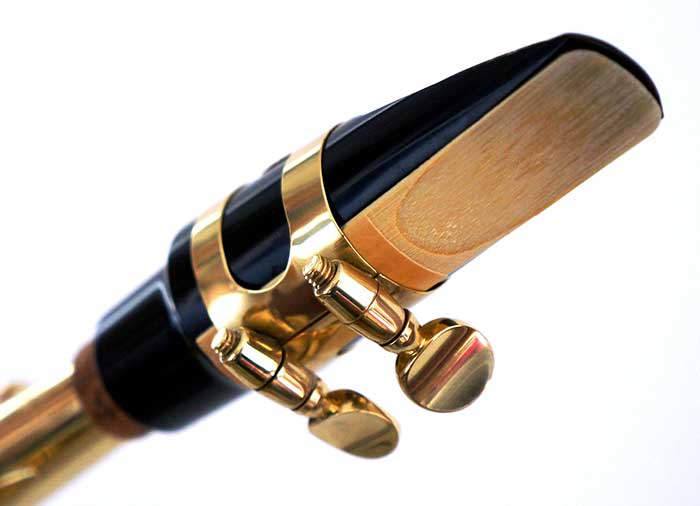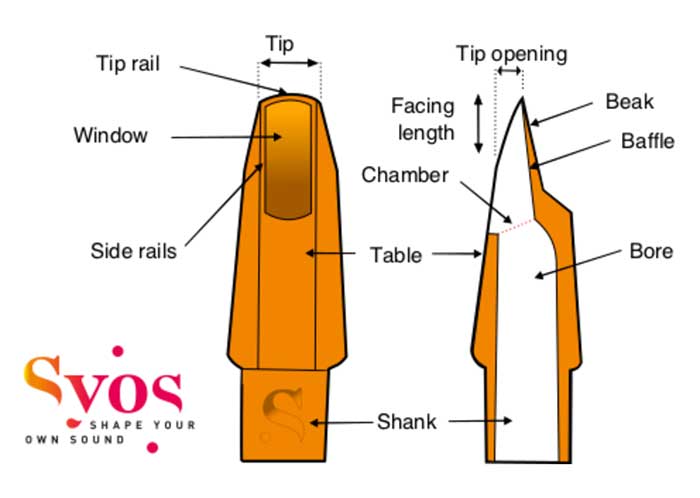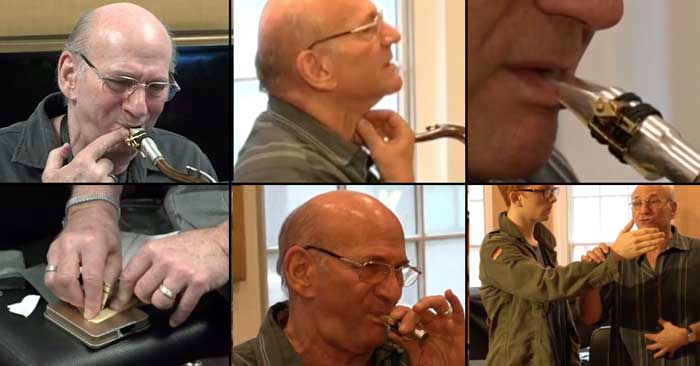A Guide to Purchasing a Saxophone Mouthpiece

The mouthpiece you use on your saxophone contributes a great deal to the sound you produce on the sax. It creates a link and bond between you and the saxophone. Because of how important the role of the mouthpiece is in shaping your “tone-signature” on the sax, it is one accessory you should always take extra precautions when choosing.
The right mouthpiece can be a trusted companion in your beginning years of playing the saxophone, and can help you grow and mold a unique sound, regardless of your style or genre. It can also be a very much-needed advantage if you are already a seasoned player. Whatever the case, you can’t put a price on having a mouthpiece that makes it as easy as possible to achieve the sound you are looking to produce.
Getting the right mouthpiece for your saxophone does not entirely boil down to finances. As a matter of fact, finances should be the last thing to consider. The perfect mouthpiece is that which gives you the desired comfort, flexibility, and overall tonal color that you desire. You could play with the best professional model saxophone, but with the wrong mouthpiece, you might not be happy with your sound. In this article, we will discuss the general factors to consider when choosing a mouthpiece for your saxophone.
Style of Music
This should be the first thing to consider when choosing a mouthpiece for your saxophone. Different styles and genres of music have different tonal requirements for the saxophone. A jazz player is not expected to sound like a classical music player. A pop saxophonist is not necessarily expected to sound like a straight-ahead jazz player.
For example, when playing classical music, the saxophone is expected to blend in perfectly with other members of the woodwind family. It would be a bit out of place to choose an overly bright, dark, or loud mouthpiece that will make you stand out from the rest of the orchestra. The goal is to blend in as much as possible. For styles like this, you will need a pretty average mouthpiece that is free blowing and also blends perfectly well with the rest of the band.
On the other hand, if you are playing an expressive style like jazz or pop that requires you to stand out as much as possible, you should not shy away from mouthpieces with distinctive characteristics. This is because your goal (oftentimes) is to sound as distinct as possible.
Also, because you will most likely take solos in styles like jazz, blues, or pop, you will need a mouthpiece that is loud enough to cut through the rest of the band and also help you with distinctive musical interpretations. Even if you are a total beginner, you should think about the style and players that catch your attention, as this should be your first consideration before choosing a mouthpiece for your saxophone.
Materials
Generally, you will always come across mouthpieces made of either ebonite (rubber) or metal (brass, stainless steel, or bronze). It is generally believed that metal mouthpieces sound a lot louder and fatter than typical rubber mouthpieces. This, however, is a controversial topic.
The truth is that these two materials sound quite different from each other. Which sounds better or louder might just be a matter of perception and personal taste. But, it is true that many jazz mouthpieces are made of metal, while standard and classical mouthpieces are often made of rubber. I personally find metal mouthpieces a lot brighter than their rubber counterparts. The key takeaway here is that they sound quite different, and it is your duty as a player to choose which suits your style of music or which recreates the tonal color you have in mind.
Mouthpiece Basics

Tip Opening
The tip opening is simply how wide the gap is between the end of your reed and the tip of your mouthpiece. This is important because this controls not just how much air gets into the saxophone, but also how much the reed vibrates. Because of this, the wider the tip opening, the louder and more dynamic the mouthpiece will sound.
The downside, with very wide tip openings is that they normally require more air and energy to play on. Beginners might tire out way too quickly. The numbering system used to measure tip opening is not in any way universal. But anything that has the number “4” is a good starting point.
The Baffle
This is the top part of the mouthpiece that will slope down into your mouth. A high baffle (thick) will give an edge or projection to your sound. A mouthpiece with a low baffle (thin) will not project as much, but it will produce a slightly darker sound, and can also be a bit harder to blow.
The Table
This is the part of the mouthpiece upon which where the reed sits. This part of the mouthpiece should be as smooth and flat as it can possibly be. For smoothness and evenness across the range of the instrument, the reed has to sit very securely on the mouthpiece’s table. The more balanced the contact between the reed and the mouthpiece, the better your tonal production and overall reed function.
Evaluating the Table of A Mouthpiece
The primary thing you will want to look out for in regards to the table is flatness. Apart from other things like sand finishing and polish finishing, you should really look out for how flat the mouthpiece table is. When picking up a mouthpiece, look at it closely and first check if the side rails (the edges) are properly finished. Turn the mouthpiece around and look at the window (the square-like front opening) to see if there are any manufacturing imperfections.
Every edge of the window should be accurately smooth. Also, check to see the evenness of the baffle. A mouthpiece with an uneven baffle will always squeak whenever being played. The most important aspect of this evaluation should be the flatness of the table, and one way to check for that is to look for a truly flat object. Although many people might use different objects, I recommended something like brass or metallic ruler. Place the flat surface of the ruler against the supposed flat facing of the mouthpiece.
After placing the ruler against the facing of the mouthpiece, look for a light source and inspect for any air space or light spillage. If no light can pass through, then the table is perfectly flat. It is important you do this check because this gives you an insight as to how your reed will sit on the table of the mouthpiece. When placing the metallic ruler, do not only place it face down against the mouthpiece, but try to align the side rail of the ruler with the side rail of your mouthpiece.
This way, you will have a more accurate evaluation of the table and the overall flatness of the mouthpiece. Another thing you can use for this evaluation is an accurately flat glass plate from a glass shop. The goal here is to measure the flatness of the mouthpiece table using an object that is one hundred percent flat as a reference or standard.
How to Aurally Examine A Mouthpiece Before Purchasing One
Although physical examination is very important, aural examination (examination by ear) is also very much needed. At the end of the day, everything boils down to what you or others are hearing. This is why I see this as the most important form of examination when buying a saxophone mouthpiece. This is also quite simple. You need to take into consideration the aural perspectives of two people – yourself and your listeners.
I believe that before you purchase any mouthpiece, you should already have the sonic imprint of the tone and timbre you wish to produce or replicate in your mind. This might be from listening to other players of the saxophone. Simply listen to yourself playing on different mouthpieces and choose that which closely matches the sound you wish to produce. A very simple but effective trick is to record yourself while playing. When listening to a recording of yourself, you can spot certain nuances you would naturally not notice while playing. This is because when you are playing, your brain is, of course, busy actually operating the instrument.
If recording yourself is something you can not afford to do, then simply enroll a second pair of (trusted) ears. A musically-inclined friend, a teacher, or even a store employee with a good sense of saxophone sound should be able to offer both positive as well as critical listening. A combination of both physical and aural evaluation will put you on the path to finding your ideal saxophone mouthpiece.
Conclusion
Understanding how all of the things discussed in this article affect the sound your mouthpiece produces will help you make a more informed decision. However, it is not always a case where “one size fits all.” The perfect mouthpiece for on jazz saxophonist might be that with a wide tip opening, while another jazz saxophonist might play just fine with a narrow tip opening.
Metal mouthpieces with wider tip openings are generally used by jazz and pop musicians. Classical musicians often go for ebonite mouthpieces with narrower tip openings. The ligature and the reed you use often play a very important role in how your mouthpiece will sound at the end of the day. Do not shy away from experimentation, as it will be your best adviser in this case.
To conclude, as a general rule of thumb, it is always advised (if possible) that you should take out some time to play a wide variety of mouthpieces before proceeding to make a purchase. Best of luck in your saxophone mouthpiece hunt!






September 19, 2022 @ 6:47 pm
Good information, I like this articles.
October 12, 2022 @ 9:27 pm
What about the shape of the hole inside the chamber as there are different shape like circle and square……etc
January 3, 2023 @ 2:23 pm
I am a resuming alto sax after a long layoff. I want a soft, mellow tone (but not as sweet as Guy Lumbardo) to use in a tiny band. We play pop and old ballads (1940’s -1980’s). I have my old Selmer Paris Mark VI with a Selmer Soloist C** mouthpiece. I’m still experimenting with different brands and strengths of reeds. My current setup is nice for solos but much too strong and piercing otherwise. I would like to look at other mouthpieces but the terms used to describe the different brands and models are very confusing and sometimes contradictory. Frankly, what I see on You Tube all sounds very much alike. Do you have any suggestions for a new mouthpiece?
December 8, 2023 @ 6:34 am
I have been also getting back into playing my Horns (alto & tenor) and I also have been trying and experimenting with different mouthpieces and even reads. It is truly tuff to find that perfect match. Plus it’s super costly. I tried metal vs rubber or ebonite and I still ended up using my old school rubber mouthpiece. Of course I had the same tuff time with Reeds. No shocker ..I know. As of to date. Using the Boston Sax Reeds. Still trying to find that Otto or Myers that will work. Good luck
February 24, 2024 @ 12:54 am
Material of a mouthpiece doesn’t make any difference, that has been shown over and again by professional players as well as scientific studies. If the internal geometry is the same, the mouthpieces will have the same spectral composition of fundamentals and overtones regardless of material used. On a side note, I am making custom mouthpieces for saxophones.